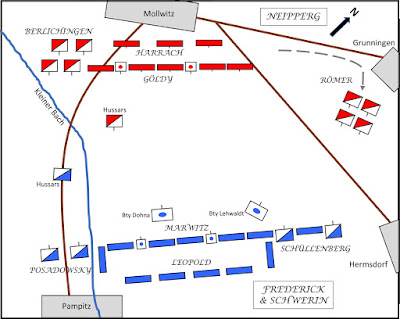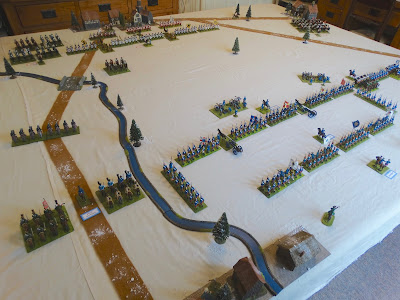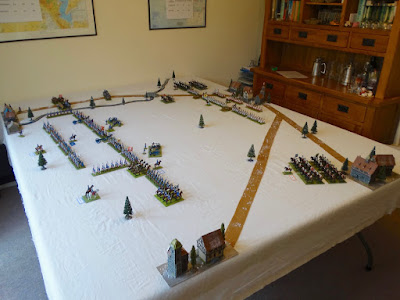When developing my set of Napoleonic rules, one of the first tasks I set myself was to try and understand the change in tactics that took place between the Seven Years War (with which I was familiar from developing Honours of War) and the Revolutionary and Napoleonic Wars. What was so different about Napoleonic tactics that made it a more complex and demanding period to wargame? And what were the reasons for the differences, such as the reliance on squares, the use of the columns of manoeuvre and attack, and the increased use of skirmishing infantry?
To bring my thoughts together I wrote the following short essay. It can be found and freely downloaded in the files section of the online group for Shadow of the Eagles, with the full footnotes present (you will need to join the group to access the file). For the purposes of this post, I should note that the main sources for my investigation were:
Brent Nosworthy: Battle Tactics Of Napoleon And His Enemies
Paddy Griffith: The Art of War Of Revolutionary France 1789-1802
George Jeffrey: Tactics And Grand Tactics Of The Napoleonic Wars
Robert Quimby: The Background Of Napoleonic Warfare
I am, of course, no expert in this period of warfare, and the essay should be read as being my own current understanding of the subject, rather than any form of authoritative statement. I present it here hoping it may be of interest, and perhaps form a basis of discussion or further research for readers.
 |
| François Gérard, 'Napoleon at the Battle of Austerlitz'. |
Ancien Régime To Grande Armée
What we usually call ‘Napoleonic Warfare’ was not created by Napoleon Bonaparte - Napoleon was an extraordinary military leader but no great innovator. He inherited an army and a system of warfare that had its origins as much in the 18th century as in the French Revolution. Nevertheless, ‘Napoleonic Warfare’ is usually described as being dramatically different from what came before. Having already published a set of wargames rules set in the mid 18th century, it was important for me to establish what was new about warfare between 1792 and 1815, and how these changes in warfare came about. This is particularly important as many of France’s opponents in this period were still using some or all of the old methods, and this clash of different methods gives Napoleonic wargaming much of its flavour. What follows then, is my appreciation of the tactical and grand tactical developments that shaped warfare in the period covered by Shadow of the Eagles.
Changes in infantry tactics were the most substantial and significant ingredient of these new developments, although cavalry and artillery benefited as well. Particularly fascinating is that these changes started with experiments in drill at the sub-tactical level, but the full flowering of the new ways of warfare depended on a range of broader contributory factors, including the very nature of the French Revolution itself.
We should start, then, with those ‘sub-tactical’ roots. Two new developments in drill originated in Prussia during the mid-18th century, and they were subsequently developed for the French Army by the Comte de Guibert, chief military advisor to the French Government 1787-89. These were the replacement of ‘processional’ deployment from column to line with the ‘perpendicular’ method; and the discovery of how to form ‘closed squares’.
The first meant that each battalion could now march up to its deployment point in column and then change directly into line, instead of forming part of a ‘procession’ of other battalions in column who would have to march across the front of the enemy (exposing their flank) before halting and quarter wheeling into line (fig.1). The process of changing from column to line was thus both much quicker and much safer under the perpendicular process. Battalions, brigades or divisions could change into line much closer to the enemy without undue risk – 400 to 500 paces, rather than at least 1000 paces and often more.
The second development, ‘closed squares’, was discovered during experiments in drill when it was found that a closed column (a column with the minimum interval between successive ranks or sub-units) could be quickly changed into a closed square by having the men at the sides and rear face outward. This was much quicker and easier than deploying into an open square (the formation so familiar from images of Waterloo). So again, infantry could safely manoeuvre in column much closer to the enemy, in this case enemy cavalry, than before.
Neither of these methods saw much use in the Seven Years War, but were introduced into the French Army, along with many other standardisations and simplifications, by the Règlement (manual) of 1791 which was based on Guibert’s work. The innovations created a much higher level of tactical flexibility. Units in column were always going to be easier to manoeuvre than units in line, and the longer they could stay in column the better. In the words of Brent Nosworthy, these developments meant that ‘it was no longer imperative to deploy all of one’s infantry into line prior to the battle. The order to form line could be delayed until the enemy was well within sight and the commander had time to analyse his opponent’s intentions’. Even more importantly, groups of highly manoeuvrable columns could have the option of acting independently, rather than being forced to be part of a linear army formation. The infantry columns had less fear of exposing their flanks, as they could quickly deploy defensively against enemy forces approaching from any direction, by forming closed square against cavalry or line against infantry.
Columns had their drawbacks. They developed much less firepower than units in line, and their depth made them more vulnerable to artillery fire. Changing into line as enemy units came within musket range was the officially preferred option, but formation changes whilst under fire were always risky, especially with poorly trained troops. Thus if the attacking troops thought their opponents were already badly damaged or of poor quality they might simply charge in column. The mutual advantages and disadvantages of line and column also led to the famous ordre mixte (‘mixed order’), where regiments or brigades would deploy with some battalions in line and others in column, according to how their commanders perceived the situation.
Despite potential drawbacks, armies adopting columnar tactics could be freed from the single axis of attack that linear armies commonly suffered from, deriving from the need to ‘maintain the line’. A linear army would be reluctant to break up its line by attacking in different directions, both because of the physical difficulty of manoeuvring a large number of units formed in line, and because of the danger of exposing the flanks of the sub-groups. A non-linear army moving in columns could much more easily employ multiple axes of attack, with units in each sub-group able to quickly redeploy if flank threats developed. Other advantages accrued - friendly cavalry now had room to support its infantry more quickly and easily, and did not have to be confined to the flanks, whilst reserves kept waiting in columns could be more easily deployed when and where they were needed.
There were two final steps that completed the picture. The French had started to employ permanent (rather than ad hoc) brigades and divisions (the latter typically of 3 brigades) from the mid 18th century, to improve army performance. By the end of the Revolutionary Wars, this tendency had conveniently combined with the new non-linear deployment systems to create what we know as the ‘Napoleonic’ system of warfare, where brigades, divisions, and then corps (formed of two or more divisions) could manoeuvre independently, with each of these formations being commonly formed by a combination of infantry, cavalry and artillery. As Nosworthy says, this ‘provided the death blow to the single entity, single axis of operation quality of grand tactics, so pervasive up until that point’. And finally it was here that the new political and social outlook of revolutionary France came into play, creating an environment where commanders-in-chief, and their subordinates in charge of corps, divisions and even brigades, were allowed and encouraged to act independently on their own initiative as their local situation changed. The more conservative Ancien Régime-style governments and their armies would have to learn the hard way the advantages of the delegation of both authority and responsibility on the battlefield.
To step back a little, we see here the explanation of the much greater use of squares in the Napoleonic era as compared to the early and mid 18th century. It was not because the lower quality infantry of mass armies (and particularly French mass armies) couldn’t defend themselves in line any more. Indeed, if poorly trained, infantry would in any case have little chance of forming an effective square. It was rather that, in battles involving developed Napoleonic armies, the cavalry and infantry battles were no longer separate, and infantry were not depending on being formed into a continuous line of units, each protecting the flanks of their neighbours. Infantry would encounter cavalry more frequently, but could be confident of defending themselves against unexpected threats by rapid realignments and quick changes of formation. Conversely, cavalry had the potential to be more effective as it could operate in much closer support of infantry and artillery.
The other great tactical difference of revolutionary and Napoleonic warfare when compared to the 18th century was of course the much greater presence and significance of light infantry skirmishers. This type of infantry had been part of the French army throughout the 18th century, well before their value was emphasised during the French-Indian Wars and the American War of Independence. French light infantry took part in both the War of the Spanish Succession (1701-1714) and the later War of the Austrian Succession (1740-1748). Their usefulness was of course also well-known in other armies, notably in the Grenzer (‘border’) units of the Austrian army. In general, however, France was consistently ahead of other nations in the use of skirmishing tactics in the period 1792-1815, and expanded the use of such troops greatly. In fairness it should be noted that the British army also had considerable success in this field, having drawn their own lessons from their experiences in North America.
On the battlefield, skirmishers could be very effective in seizing and holding broken or wooded terrain. They also commonly acted in front of the main line of battle, using controlled, aimed fire to harass and hopefully disrupt formed enemy infantry whilst presenting difficult targets to any return fire. This was a function they could perform in attack or defence. However, their effectiveness in these roles was highly dependent on their level of training. Most nations in our period eventually had a least one light company in an infantry battalion trained to split off when necessary for the skirmishing role and to act in concert with similar companies from other battalions in the same regiment or brigade. Whole battalions were also raised who were supposed to be able to act either as formed infantry or skirmishers, most famously the légère battalions in the French army. In the poorly-trained early revolutionary armies, whole battalions would commonly degenerate into amorphous grande bandes of loose order infantry under the pressure of enemy fire.
In summary, the assumption that battlefield columns, the use of squares and the prevalence of skirmishing light infantry were a direct reaction to the mass, untrained nature of the new armies of Revolutionary France would appear to be incorrect. The tactical changes that underlay the eventual creation of Napoleon’s Grande Armée derived from Prussian and French developments firmly grounded in the mid to late 18th century, developments which had become significant trends in French military tactics before the time of the Revolution. It would be foolish to deny that these developments were well suited to armies that had to make do with large numbers of quickly trained men. However, employing the full range of tactics and grand tactics that made up Napoleonic Warfare at its most efficient needed armies that were, in contrast, thoroughly trained and well disciplined. The revolutionary armies learned their trade as the years passed, but would not realise their full potential until the appropriate discipline, training and doctrine were provided in the famous camps around Boulogne that created the extraordinary Grande Armée of 1805.

















